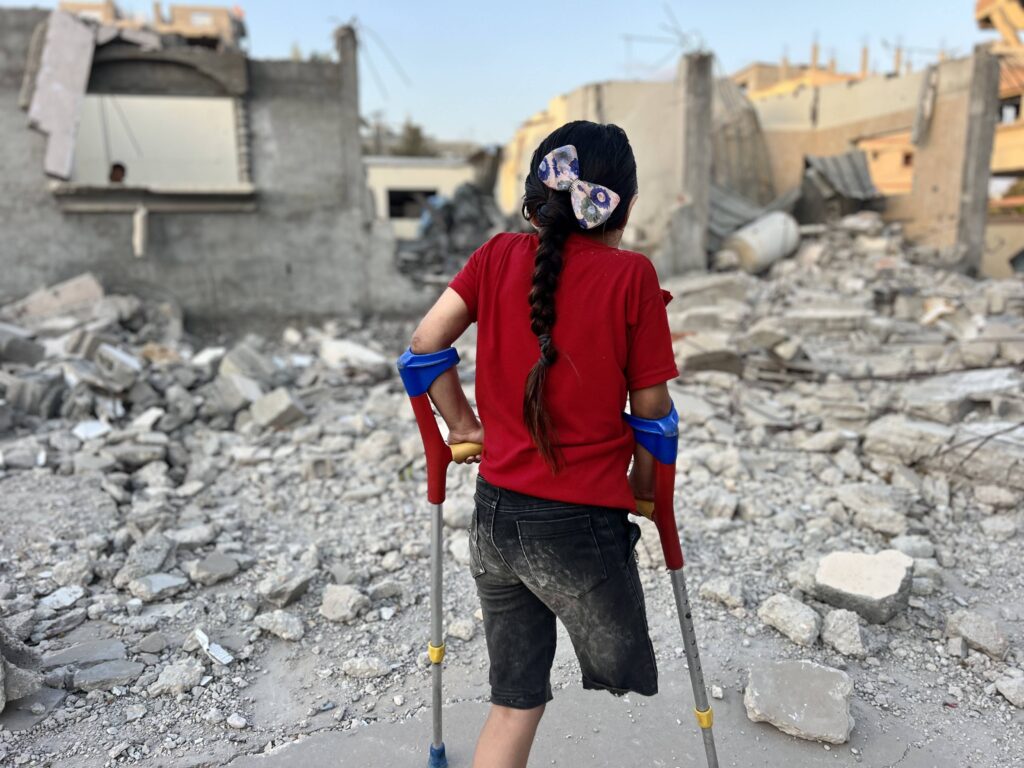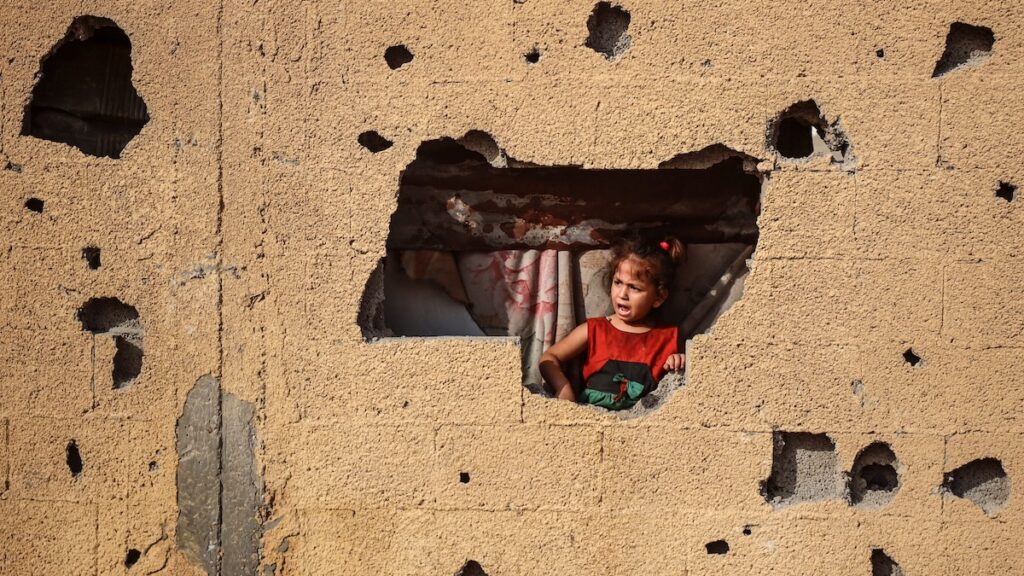Children are rascals. Every morning comes with the patter of small feet, the clink of spoons and toys spilled from where they were neatly stored the night before. It’s the chaos parents secretly cherish: proof that life is full, loud, safe.
“Oh rascal children of Gaza,” the Palestinian poet Khaled Juma wrote more than a decade ago, after 50 days of bombing that killed more than 500 Palestinian children. “You who constantly disturbed me with your screams under my window / You who filled every morning with rush and chaos / Come back — and scream as you want … just come back.”
Today, two years into what the U.N. has recently recognized as Israel’s genocide in Gaza, Juma’s plea is louder than ever. The children of Gaza are quiet. Some no longer speak. Some no longer cry. A few still play, but their games are different now. They reenact airstrikes. They pretend to die. They dig mock graves with their fingers. And they wait, not for the war to end, but for it to come for them next.
Teresa Bailey, a child psychotherapist with more than 30 years’ experience working in England’s National Health Service, tells Analyst News this is an outright “a war on babies” — the methodical destruction of a generation before it can grow up.
A founding member of the U.K. Palestine Mental Health Network, Bailey has edited the Journal of Child Psychotherapy and Independent Psychoanalytic Approaches with Children and Adolescents. In the 1980s, she worked in Tanzania with South African child refugees and young detainees who had undergone torture. Now, she’s campaigning for other mental health professionals to speak out on behalf of the children and families undergoing genocide in Gaza.
A war on children

Every one of Gaza’s 1.1 million children now needs mental-health and psychosocial support. “There’s nowhere else in the world where UNICEF has ever said that every single child needs mental health support,” James Elder, UNICEF’s global spokesperson, has noted.
More than 50,000 children in Gaza have been killed or injured since October 2023; some 132,000 children under the age of 5 are at risk of death from acute malnutrition. In July, UNICEF reported that an average of 28 children — an entire classroom’s worth — are being killed every single day. UNICEF also says the Gaza Strip has the highest number of child amputees per capita anywhere in the world, with more than 3,000 limb amputations taking place since October of 2023.
“There’s nowhere else in the world where UNICEF has ever said that every single child needs mental-health support.”
“Mothers in Gaza can no longer look forward to having a baby,” says Bailey. “Who knows if that baby will be born alive — or remain alive once it’s out of the womb? At Al-Nasr Hospital, five premature babies were found dead in their incubators,” she says. “At Kamal Adwan Hospital, soldiers actively prevented staff from reaching infants in intensive care. Malnourished mothers can’t produce milk, and baby formula isn’t allowed in. What are they supposed to give their babies?”
Bailey describes what we can see — the hospitals, the mothers, the babies. But the children themselves tell us what it feels like in the questions they whisper. “A child asked, ‘Do Israeli pilots who bomb children have children?’” Bailey says. “That really got to me.”
It’s one of dozens of such questions that the Palestine Trauma Centre U.K. has collected from children in Gaza: After we die, will I hear your voice? When a missile hits us, do we feel pain or die immediately? I don’t want to die in pieces. Do children who have their legs amputated grow new legs?
One father’s story still haunts Bailey. His wife had just given birth to twins. He ran out to register their birth, looking forward to coming home to see them. By the time he returned, his twins, his wife and their grandmother had all been murdered.
These are not isolated tragedies but windows into the systematic destruction of childhood.
Trauma without end
Psychologists use the term post-traumatic stress disorder, or PTSD, to describe the effects of trauma once the threat is over. But in Gaza, the trauma is ongoing and relentless.
“The ‘P’ in PTSD is post,” Bailey explains. “But children in Gaza are living with traumatic terror every single day, all day. There isn’t a safe place. Their minds, their brains, are on high alert all the time.”
She compares it to an American school shooting. “There’s no point in sending in a mental health professional while the shooter is still in the building. You wait until it’s safe. But in Gaza, the perpetrator is never removed. The trauma never stops.”
Trauma not only leaves emotional scars, it rewires a child’s brain. Psychiatrist and trauma researcher Bruce Perry has defined trauma as any experience that overwhelms a child’s ability to cope. Because children’s brains are still developing, they are especially vulnerable. Perry describes brain development from the bottom up: survival systems mature first, higher reasoning last. Under continuous trauma, children are forced to operate from the lower regions, locked in fight, flight or freeze.
“There’s no point in sending in a mental health professional while the shooter is still in the building. You wait until it’s safe. But in Gaza, the perpetrator is never removed. The trauma never stops.”
In Gaza, where bombardment is constant, this system is activated nonstop, Bailey says. This disrupts the normal growth of higher brain functions that support language, learning and emotional regulation. UNICEF and the World Health Organization use the term “toxic stress” to describe the impact on children living in war zones — a state of prolonged physiological strain that can rewire the brain and undermine healthy development.
Psychiatrists have used the term continuous traumatic stress disorder, or CTSD, to describe trauma without an end point — a condition first identified in apartheid-era South Africa. Dr. Samah Jabr, head of the Mental Health Unit with the Palestinian Ministry of Health, has written extensively about CTSD in Palestine, where many children under 18 have already lived through four or five wars before October 2023.
The consequences are visible: mutism, nightmares, regression, even suicidal thoughts — a child’s way of wishing for an end to pain in abnormal circumstances, Bailey explains. The logic is simple, she says: “If I can die, I can be with my mum and dad again. I want to go to heaven to be with my mum and dad.”
Even play has changed. “The play that children are showing is about war,” Bailey says. “They pretend to die, they dig graves with their fingers.” And then there is the soundscape of Gaza. “Even when I’m speaking to young people there [over the phone], I can hear the drones buzzing overhead,” Bailey says, “They hover like monsters, all the time. How can a child’s nervous system ever regulate itself under that?”
Shattering safety

WCNSF. Wounded Child, No Surviving Family. It is an acronym used by Gaza’s doctors for a child who arrives at the hospital wounded and alone — no parent or family left. It is how healthcare workers in Gaza record the collapse of a childhood.
About 40,000 children in Gaza have lost one or both parents since October 2023, according to some estimates. Aid groups describe them in clinical terms as unaccompanied minors or double orphans, categories that mask a simple truth: these are children who have lost the people who made the world safe.
Bailey explains that even for children who still have parents, safety itself has been shattered. “That sense of parental omnipotence,” she says, “the belief that mum and dad can protect you — once it’s gone, it never comes back.”
Parents are coping with their own trauma while trying to care for surviving children. Many have lost entire families, yet must still cradle the living. “A parent in survival mode finds it hard to regulate themselves enough to comfort a child — and yet somehow, again and again, they do,” Bailey says.
Two of the greatest fears of every small child are abandonment and obliteration. In Gaza, these fears are the daily gamble.
But the cost to children is immense. Bailey explains that two of the greatest fears of every small child are abandonment and obliteration. In Gaza, these fears are the daily gamble. The developmental need to believe in a parent’s capacity to protect them is destroyed prematurely, and in the most frightening way. When parents cannot steady them, children lose the co-regulation that normally anchors safety, leaving the very core of childhood shattered.
The genocide has also erased the ordinary structures of childhood. According to the Palestinian Centre for Human Rights, since October 2023 some 785,000 students have been deprived of education — now entering a third year without school. More than 90% of school buildings have been destroyed or damaged.
Playgrounds and classrooms are gone; routines have vanished. Children in Gaza now grow up in tents crowded with displaced families, under constant threat of bombardment. Heat, hunger and sewage replace the rhythm of school bells, games and learning. There is no quiet, no space to play, no scaffold on which a normal childhood can grow.
Palestinian scholar Nadera Shalhoub-Kevorkian has called this process unchilding — the stripping away of the right to be a child. She defines it as “the authorized eviction of children from childhood,” a condition in which Palestinian children, under Israeli settler-colonial rule, are policed, punished and even framed as threats before they are born.
This erasure is compounded in Western narratives, where Palestinian children are routinely described as “young men” or “militants.” Their innocence is erased once by bombs, and again by language.
In Gaza, the loss of parents, schools and safe play are not separate tragedies but part of this wider regime. Childhood itself is dismantled, leaving children suspended between survival and disposability.
“Come back – / And scream as you want, / And break all the vases, / Steal all the flowers, / Come back, / Just come back…” Khaled Juma ended his poem back in 2014.
The children of Gaza deserve to return to mischief. To the patter of bare feet down a hallway. The clink of spoons against full bowls. Toys scattered before the day has even begun. They should run toward their parents, not away from the flash of bombs. They should scream from laughter, not terror. They should be grass-stained and muddy from playing outside, not caked in the rubble of another U.S.-funded Israeli bomb.
Until that day, we owe them more than our grief. We owe them the mornings they have lost.
Resources and ways to help
The following resources and suggestions were highlighted by Teresa Bailey, a child psychotherapist with more than 30 years of experience, who emphasized the importance of reflecting, learning and supporting in tangible ways.
Reflect:
- Bailey encourages everyone to spend 15 minutes watching their own children or the children in their life. Remember that Palestinian children are just like them — they laugh at the same things, fear the same things.
Learn:
- The Ethnic Cleansing of Palestine by Israeli historian Ilan Pappe
- Will Gaza’s children face trauma and PTSD forever? Al Jazeera interview with Dr. Samah Jabr, Palestinian psychiatrist and former head of the Mental Health Unit of the Palestinian Ministry of Health
- Radiance in Pain and Resilience: The global reverberation of Palestinian historical trauma and Healing Through the Skies: Coping With Grief Through a Therapeutic Group Activity for Children in Palestine by Dr. Samah Jabr
- Reports by Dr. Yasser Abu Jamei, director of the Gaza Community Mental Health Programme
- Scholar Nadera Shalhoub-Kevorkian’s books and papers about the abuse of childhood in Palestine
Support:

